In a competitive marketplace, you need to stand out from the crowd. A strong local online presence is vital to compete and be found by customers in your local area. If your dental practice is already invested in an SEO strategy to increase its online visibility, you will be aware that Google uses a wealth of clever algorithms to rank the results it considers most relevant to a search query. While nobody except Google’s masterminds will know the exact workings of these rules, we do know that local search engine optimisation (local SEO), has an algorithm all of its own.
Local search engine marketing is a branch of SEO that focuses on optimising a website so it can be found in local search results. When patients are deciding on a dental practice, they will be drawn to those practices that deliver the information they are seeking, as seamlessly as possible, on a device they are searching on, at a location near to them. If you are looking to reach more patients, on more devices and benefit from the 246,000 searches for ‘dentists near me’ made on Google in the UK every month, there are plenty of things that your practice can do to optimise the effectiveness of its results. In our local area of Bromley, there are over 1,000 searches a month for ‘Dentist Bromley’, so it is a worthwhile exercise to put aside time for.
In this guide, we are going to show you all the ways you can tweak your local search engine marketing strategy to reach more potential patients and drive more online and offline traffic to all your brand’s locations. Better still, they are all tips that you can have a go at inhouse without hiring the help of a digital marketing expert.
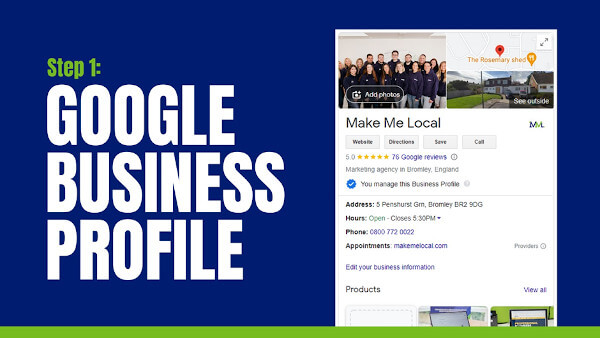
1) Google Business Profile (GBP)
Listing your dental practice on Google’s local listing platform, Google Business Profile(GBP) and optimising your practice’s information effectively, is an essential part of Local SEO. Setting up your profile correctly and optimising it well, will allow your practice to target a search with local intent (‘dentist Bromley’ for example). This means, when a potential patient searches with local intent, your business has a good chance of appearing in a prime position on the search results page, namely the ‘Map Pack’ snippet, as well as Google Maps and Google’s Local Finder.
If your practice is not yet listed on Google’s Business Profile, we recommend doing this asap. It’s very easy to claim your free listing. Once claimed and verified you will need to ensure that all your practice information is accurate and complete, from the practice name, address, and phone number (NAP), to practice opening hours and, an accurate, informative description of your practice.
An important section to master within your GBP listing is ‘Categories’. Many dentists offer more than one service, so ensure to set ‘Dentist’ as your primary category, but include as many relevant secondary categories as possible, these may include:
-
-
- Cosmetic dentist
- Pediatric dentist
- Dental hygienist
- Dental implants periodontist
- Dental clinic
- Dental care centre
- Dental implants provider
- Dental radiology
-
Including all your categories, will help your listing/practice get found when someone uses similar phrases in their Google search query.
Adding your business logo and cover photo is important too, as they will be the first things a potential patient sees when your GBP listing is found, and we all know how important it is to make a great first impression:
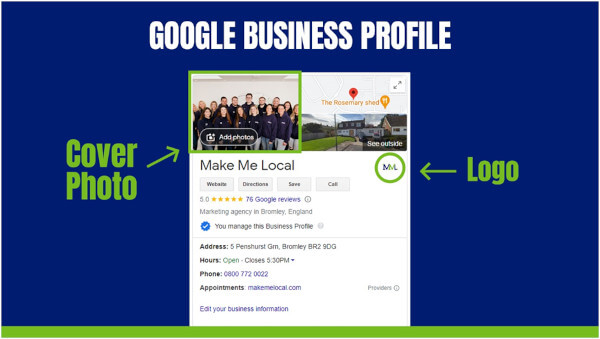
Read our guide on how to optimise your Google Business Profile which will take you through everything you need to know step by step.
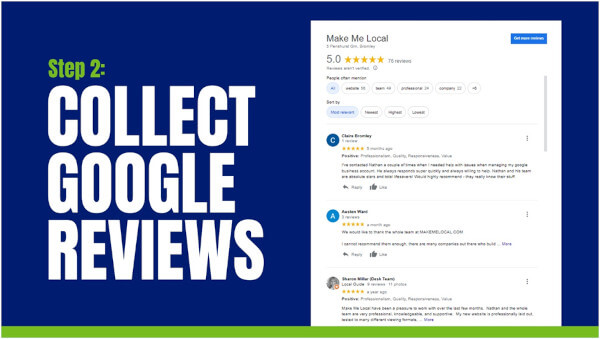
2) Collect Google reviews
Online purchasing has soared to an all time high in recent years, mainly due to the ease, simplicity, and speed of the whole shopping experience. However, because shoppers are not able to see or experience anything tangible before they commit to a service or buy a product, they rely heavily on the opinions of shoppers that have had experience with a brand. In fact, a whopping 72% of local consumers read reviews before taking any online action. What has this got to do with local SEO, I hear you ask? Well, in short, collecting genuine online reviews will help your listing on Google Business Profile climb the ranks into the top local search ranking results, providing your dental practice with an edge of its competitors.
Furthermore, local SEO aficionados, Whitespark, found reviews to be the second most important ranking factor for rankings in the Map Pack and Local Finder, in their most recent report. This annual report by Whitespark is the industry’s go-to resource for understanding how to rank in Google’s local search results. It summarises the results of the annual survey results gathered from the industry’s top local search experts. The survey results determine what is working to drive rankings and conversions in local SEO, and what’s not.
If you are not actively collecting Google reviews at present, we suggest making it part of your SEO and wider marketing strategy, asap. It isn’t a difficult process to master, we’ve even put together a quick and easy tutorial on how to collect Google reviews, which includes a free email template that you can use.
Don’t forget, all reviews can be positive for your practice, whether they are positive or negative, as long as you respond promptly and politely. He’s our advice on turning a negative review into positive feedback for your practice.
If your practice boasts more than 40 patients, you might want to consider our reputation management service whereby we do the legwork for you.

3) Citations (off page SEO)
Listing your practice on online directories is still relevant for SEO. Inconsistencies, errors and out of date information have the potential to harm your local SEO rankings, so it is vital to focus on NAP consistencies across all online listing sites to build a dependable online presence. Incorrect online contact details will frustrate, confuse and deter potential patients before they even make contact with your dental business.
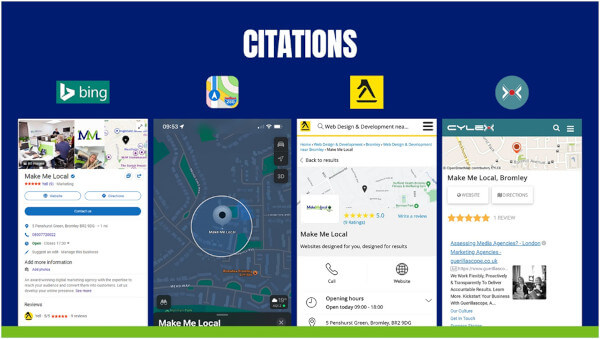
At the very least, we recommend listing your dental offering on the following directories:
- Apple business register: https://register.apple.com/placesonmaps/
- Bing Places: https://www.bingplaces.com/
- Yell.com: https://www.yell.com/
- Cylex: https://www.cylex-uk.co.uk/

4) Keyword research
Local keyword research is important to getting your website noticed by search engines like Google. It allows your dental practice to understand what people type into Google when looking for your services. It sounds simplistic, but you will be surprised how many business owners guess these keywords and assume they already know how people are searching for their business’s services. Keywords tell Google what your website is all about and what you do as a company. A local dentist in Bromley for example, may want to bring in patients to their website via Google by targeting keywords like:
- General dentistry
- Emergency dentistry
- Dental implants
- Teeth whitening
- Root canal
- Crowns
- Children’s dentistry etc.
A successful dentistry website should and will include these words in multiple places, including the homepage, blogs, services, page, and even reviews. When someone types a query into Google, Google crawls all the web pages in its index to find the most relevant matches and lists them in its search results. The more you mention the keywords that Google deems relevant on your website, the more your website will show up in relevant search results.
How do you carry out keyword research for your website?
There are lots of SEO tools on the market you can use to help identify keywords. We are fans of SEM Rush, SE Ranking and Mangools -all these offer free trials.
Firstly, list out all your services. You will want to dedicate a website page for each of these services, so you will need to research what local keyword opportunities are available around these service areas. For example, if you offer hygienist services, you will want to create a Dental Hygienist page on your website and fill it with content that that targets the local keyword ‘Dental Hygienist in [your location]’. You can then repeat this process for all the services.
Typically, the homepage of your dental practice website should be optimised to target anyone searching for ‘Dentist in [your location]’.
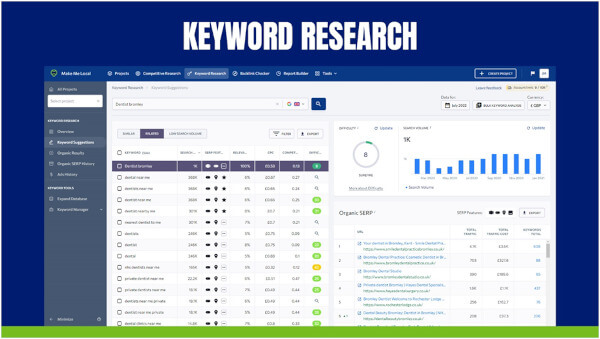
In short, keyword research allows you to understand the opportunities available to your business, what service pages to create for your website and what keywords to target on each of those pages.

5) On page SEO
Once you’ve completed your keyword research to map out which of your services you will dedicate web pages too, you will want to ensure the content on those pages are written with Google in mind, by ensuring the content satisfies the specific keyword you are trying to target. By optimising your web page content in this way, you will play to Google’s genius and the algorithms it uses, to determine what pages are considered good enough to rank in its search results – we refer to this as ‘on page SEO’. Getting your on-page SEO right will not only improve a user’s experience with your website, but it will improve your website rankings too.
To optimise content to target a specific keyword you will need to have an effective page title, meta description, primary header (H1) and content should include all the keywords associated with your primary keyword. For example, let’s say that you are a Bromley-based dentist trying to optimiseyour website homepage to target search around the keyword ‘Dentist in Bromley’:
- Your page title would be ‘Dentist in Bromley – [brand name]’
- Your meta description should incorporate ‘Dentist in Bromley’ within it.
- Your primary header [H1] should incorporate ‘Dentist in Bromley’.
- The content on your homepage should be written around being a ‘Dentist in Bromley’.
Keyword research and on page SEO is a specialist talent and takes time and patience to master. While you might be able to complete some of the basic optimisations yourself, you may want to enlist the help of a professional SEO expert to take full advantages of the opportunities open to your business resulting from effective SEO.

6) Links
To get your content seen and ranked by Google in its search results, it needs links. Google finds your web pages best when they are linked to from somewhere on the web. You need both internal links (meaning links from other pages of your own website) and external links (links from pages on other websites) for good SEO.
Internal links
Both users and search engines use links to find content on a website. Search engines use links to navigate a site and will not ‘see’ a page if there are no links to it.
Internal links connect website content, providing Google with an idea of the structure of the website, as well as enables anyone visiting a site to navigate round easily and successfully. Links can be used to create hierarchy on a site, allowing you to provide the most important pages with more link value than other, less valuable pages. The more links a significant page receives (like a homepage where there are lots of call to actions), the more important it will seem to search engines. That’s why good internal links are crucial to SEO.
The two most important things to take on board with internal linking:
- Keep links relevant. Only link to another page on your site if it is completely relevant to your theme. When you have written several articles around a particular topic you should link them with each other. This shows Google (and users) that those articles are topically related. You can see that we have linked to other blogs within this article directly from sentences in the copy, but you can also add links at the end of your article too.
you will also want to link hierarchical pages on your website together. Linking parent pages to their child pages (and vice versa), as well as linking sibling pages together, helps Google group content and determine which pages are the most important. - Only link once to the same page. You should not internally link to another page on your website more than once (from the same webpage).
External links
External links are hyperlinks that points to a target page on a different website, typically to a source that adds credibility to the point you are making within your content. External links added to your content assists search engines in determining the usefulness and quality of your pages. High-quality pages usually link to other high-quality pages therefore, search engines will view your content well, helping you rank higher and improve your SEO. External links improve your website authority. If you have linked to a high-quality page on a high-quality site indicates your content is credible to search engines.

7) Technical SEO
cannot discuss SEO without getting a little bit ‘techy’. It’s no good creating engaging, well-written content for your website, that has all the potential for converting users into customers, if search engines can’t browse your website and index it, properly. There are a few behind the scenes tactics you need to master when creating and optimising your website, to ensure search engines can crawl, index, and render it effectively. These tactics are known as technical SEO.
Technical SEO includes perfecting the following things on your website:
URL structure
A well-presented URL will accurately reflect what is on the page, enabling search engines to see what’s on it and how the website is structured. The web page you are reading right now is a blog post about local SEO for dentists. The URL structure also reflects this with “/blog/local-seo-guide-dentists”.
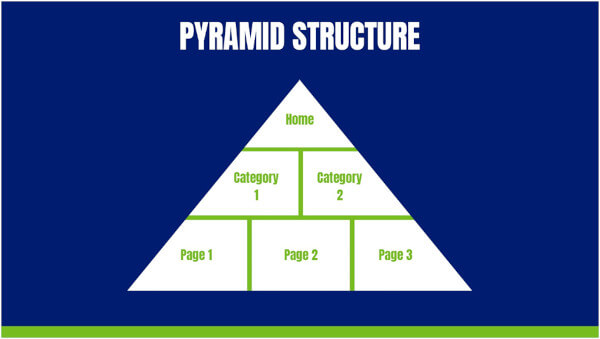
SEO expert, John Meuller recommends websites follow a pyramid structure whereby the home page is focused on the most top level keyword and the more specific categories and pages at the lower levels, becoming more obvious the deeper you delve into a website.
Robots.txt file
Every website needs to have a Robots.txt file and it should link to the sitemap within it. Put simply, this file boasts a set of instructions that tells search engine crawlers which URLs the crawler can access. Robots.txt files are created and uploaded behind the scenes of your website upon its construction.
Sitemap.xml
This file lists all the pages of a website to ensure Google, and other search engines, can find and crawl them for answers to search queries. A sitemap.xml file is created and uploaded behind the scenes of your website upon its construction.
Image optimisation
In order for an image to be ‘seen’ and indexed by Google it needs three vital considerations:
- Image compression – images on your website should be compressed to the smallest file size possible. Large images will slow the website down and affect a user’s experience. Try this handy tool for compressing images.
- Image title – all images should be titled. Titles should include the keyword the webpage is targeting.
- Image ALT tag – all images should have ALT tags. Alt tags should include the keyword the webpage is targeting.
Website speed
A slow loading, mobile unfriendly website is a big turn off, and a bad page experience can quickly turn users away from your website and into the hands of a competitor. Plus, website speed is a major ranking factor. In 2021 Google introduced Core Web Vitals which are a set of specific factors (covering loading, interactivity and visibility) that Google considers important in a webpage’s overall user experience. Google uses these factors to form its “page experience” score. A score that it uses to size up a page’s overall user experience.
There are many factors that go into determining website speed such as quality of the code used, the plugins installed on a website etc. There are lots of things you can do to improve website speed including:
- Use good quality website hosting.
- Use a CDN.
- Minify CSS and JavaScript files.
- Use browser caching.
Learn more ways to speed up your website by clicking here.
Structured data (also known as schema)
Structured data is all about helping Google understand what’s on a web page.The data follows a standardised format and provides Google with clues about the meaning of a page, information about a page and how it might classify the page content.
Example structure data types include:
- Article structured data
- FAQ structured data
- ‘How to’ structured data
- Job posting
- Local business
- Person
- Video
You can use a structured data generator tool to generate schema for a page. For example, if you have an FAQs page on your website, you can enter the FAQs into the structured data generator, and it will provide you with code that should be used behind the scenes of the FAQ page to help Google decipher what the page is about.

8) Create blogs
A business blog helps drive traffic to a website. Regular blogging will provide valuable content for existing patients, gives your dental practice content to share on social media, improves your likelihood of reaching potentially new patients, and can boost conversions. Businesses that blog, will always be more likely to acquire customers because they are creating content that helps new customers discover the website, get them engaged with their brand, and encourage them to come back to the website for more. It is also a great way to get potential patients to further navigate around your website.
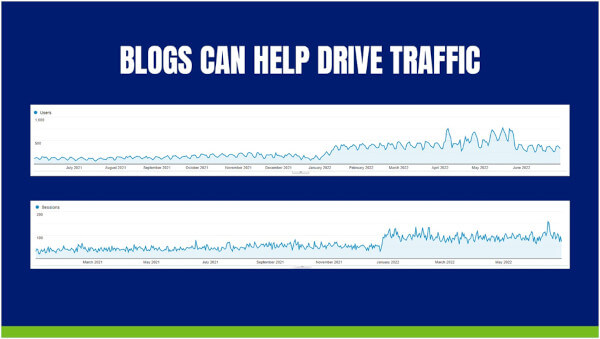
A blog also lets you share your knowledge and experience as dentists and help your practice stand out, as well as allowing you to target specific keyword phrases and build internal links to other relevant service pages on a website. For example, after the 2020/2021 pandemic, some well-placed blogs on the importance of looking after oral health would have been very useful for patients that may have neglected their teeth a little during lockdown. Plus, it allows your practice to promote its hygienist, gum health and general dentistry services.
For good writing tips and help on thinking up blog topics that pull in new patients, click here.
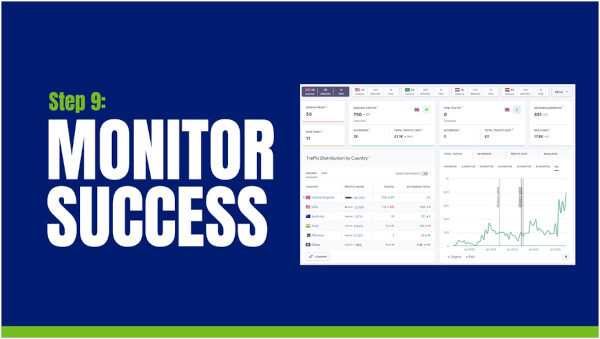
9) Monitor your success
Measuring your website’s performance is pivotal for understanding the effectiveness of your online marketing efforts. Determine which metrics are most important for your dental practice and ensure you have a good tracking system in place. This way, you have a clear picture of what is and what is not working for your business. Measuring your progress with Google Analytics is a good place to start. Furthermore, it is free and easy to set up.
Google Analytics is the industry standard web analytics platform that tracks and reports data about your website. Using it effectively will help you measure traffic, consumer engagement, and measure the success of campaigns and conversions. You will be able to understand your website, and how to leverage its performance to grow your dental practice. You will be able to answer many questions to improve your site’s performance, such as how many people are visiting the website? Which pages are most popular? Where are my users located? What types of traffic are most profitable? What sites are referring traffic to my site? What kind of devices are visitors using to access my site? And so on.
Within the Google Analytics Console you can also setup conversion tracking which allows you to see what pages of your site are generating enquiries.
Local SEO is key to capturing the attention of patients in your area. Local search platforms such as Google are increasingly integrating location-based data into their search results. This means that when someone searches for services or products and is within a reasonable distance of your brands, they should be able to find your business with ease. All the local SEO strategies outlined in this article will go a long way to helping your practice stand out in your local area.
If you are keen for your practice to benefit from an improved local SEO strategy, but do not have the time to plan and implement it, the team at Make Me Local are here to help. Whether you just want to focus on local SEO, or need some help implementing a broader digital marketing strategy, we are happy to chat through your requirements.